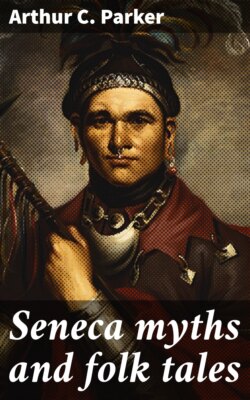Читать книгу Seneca myths and folk tales - Arthur C. Parker - Страница 9
На сайте Литреса книга снята с продажи.
FREE TRANSLATION.
ОглавлениеTable of Contents
In ancient times a race of transcendent men dwelt on the other side of the sky. In the center of a village in that land stood the lodge of Ancient One, the chief, and there he lived with his wife and one child. To his astonishment, though he had these companions, he began to feel lonely and neglected. His form grew emaciated and his “bones became dry,” for he longed for the attentions his wife now gave to his child.
Just how the poet would handle this version we hesitate to conjecture but we may easily imagine that he would make the most of the land above the sky, the celestial lodge, the age of the Ancient One, his initial joy at the birth of his child, and his gradual discovery that his wife’s affection had been transferred from him to their offspring, of the agony of soul that wilted his heroic form and caused his very bones to wither and lose their marrow, and of the final madness of the Ancient One, who (to follow the myth in its fullness), had a tormenting dream which caused him to tear up the celestial tree and cast his wife into the cavernous hole that dropped down into chaos.
The plot of this myth-tale has elements that make it excellent material for the fiction writer who would recast it entirely and weave it into the thrilling story of celestial tragedy. We have seen such attempts and have been astonished at the audacity of the writer who thus presents his product as a “genuine Indian myth.” Yet, most popular versions of Indian legends are recast to such an extent that the Indian who supplied the bones would never recognize the creature the white man “teller-of-tales” has clothed with civilized flesh. As an example of such fabrication, witness the speech of Hiawatha to the assembled tribes as presented by J. V. H. Clark in his “Onondaga.” (Vol. I, p. 28 ff.) This famous speech has been passed down as Hiawatha’s own words and has been the inspiration of more than one poet, though Clark admitted in later years that he invented the entire address, basing it upon some obscure references in the original tradition. In many a work on “Indian fables for children” the so-called fable is merely an invention, and the only Indian thing about it is the dash of Indian flavor used to give the story plausibility. Indians who have never seen or read the text of such stories of course might easily be induced in various ways to sign statements vouching for them, thus contributing to the intensification of error.
It is well to analyze the folk-tale or myth for its theme and to check it against others, thereby determining whether or not it is actually authentic. If it appears unusual and unlike anything other informants have given, it may be placed in the class of doubtful fiction, and especially so if the “fable” has a “moral” attached to it.
